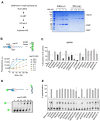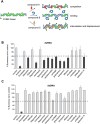Interference of small compounds and Mg2+ with dsRNA-binding fluorophores compromises the identification of SARS-CoV-2 RdRp inhibitors
- PMID: 39548173
- PMCID: PMC11568178
- DOI: 10.1038/s41598-024-78354-x
Interference of small compounds and Mg2+ with dsRNA-binding fluorophores compromises the identification of SARS-CoV-2 RdRp inhibitors
Abstract
The COVID-19 pandemic highlighted the need for the rapid development of antiviral therapies. Viral RNA-dependent RNA polymerases (RdRp) are promising targets, and numerous virtual screenings for potential inhibitors were conducted without validation of the identified hits. Here we have tested a set of presumed RdRp inhibitors in biochemical assays based on fluorometric detection of RdRp activity or on the electrophoretic separation or RdRp products. We find that fluorometric detection of RdRp activity is unreliable as a screening method because many small compounds interfere with fluorophore binding to dsRNA, and this effect is enhanced by the Mg2+ metal ions used by nucleic acid polymerases. The fact that fluorimetric detection of RdRp activity leads to false-positive hits underscores the requirement for independent validation methods. We also show that suramin, one of the proposed RdRp inhibitors that could be validated biochemically, is a multi-polymerase inhibitor. While this does not hinder its potential as an antiviral agent, it cannot be considered an specific inhibitor of SARS-CoV-2 RdRp.
Keywords: Fluorophore; High throughput screening; In vitro RNA polymerization assay; RNA-dependent RNA polymerase; SARS-CoV-2; Small molecule inhibitors.
© 2024. The Author(s).
Conflict of interest statement
Figures





Similar articles
-
Identifying SARS-CoV-2 antiviral compounds by screening for small molecule inhibitors of nsp12/7/8 RNA-dependent RNA polymerase.Biochem J. 2021 Jul 16;478(13):2425-2443. doi: 10.1042/BCJ20210200. Biochem J. 2021. PMID: 34198323 Free PMC article.
-
Construction and validation of a cell based reporter assay for identifying inhibitors of SARS coronavirus 2 RNA dependent RNA polymerase activity.Sci Rep. 2025 May 26;15(1):18443. doi: 10.1038/s41598-025-03813-y. Sci Rep. 2025. PMID: 40419748 Free PMC article.
-
Structural basis of SARS-CoV-2 polymerase inhibition by nonnucleoside inhibitor HeE1-2Tyr.Proc Natl Acad Sci U S A. 2025 Mar 11;122(10):e2419854122. doi: 10.1073/pnas.2419854122. Epub 2025 Mar 4. Proc Natl Acad Sci U S A. 2025. PMID: 40035759 Free PMC article.
-
RNA-Dependent RNA Polymerase as a Target for COVID-19 Drug Discovery.SLAS Discov. 2020 Dec;25(10):1141-1151. doi: 10.1177/2472555220942123. Epub 2020 Jul 13. SLAS Discov. 2020. PMID: 32660307 Free PMC article. Review.
-
RNA-dependent RNA polymerase of SARS-CoV-2 as a therapeutic target.J Med Virol. 2021 Jan;93(1):300-310. doi: 10.1002/jmv.26264. Epub 2020 Jul 19. J Med Virol. 2021. PMID: 32633831 Review.
References
-
- Hillen, H. S. et al. Structure of replicating SARS-CoV-2 polymerase. Nature. 584, 154–156 (2020). - PubMed
MeSH terms
Substances
Grants and funding
LinkOut - more resources
Full Text Sources
Research Materials
Miscellaneous

